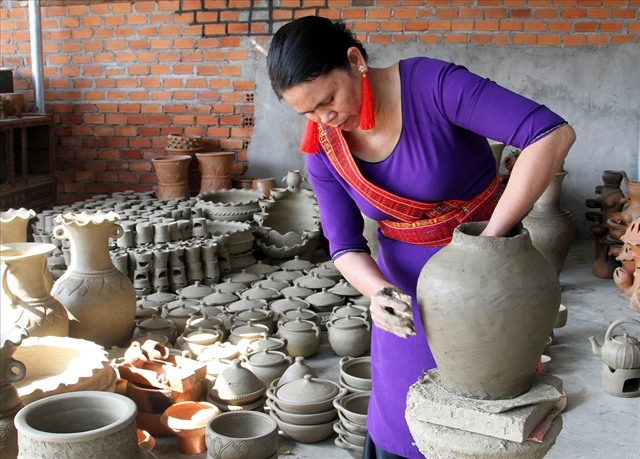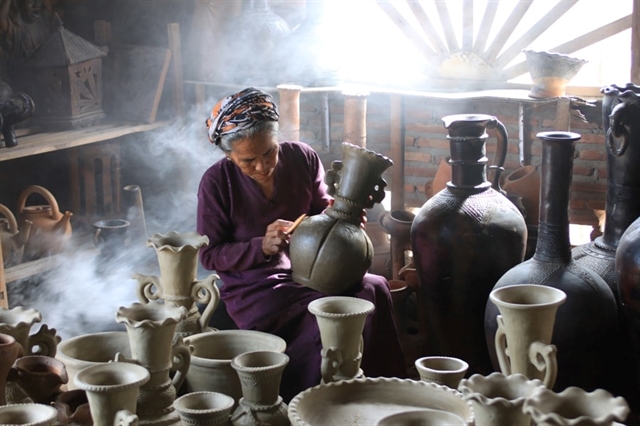October 8, 2025
KHANH HOA – One of Việt Nam’s oldest pottery villages, Bàu Trúc in Khánh Hòa Province, is to be transformed into a community tourism hub under a new initiative approved by the Ministry of Culture, Sports and Tourism.
The project, titled ‘Developing a Heritage-Linked Model Integrated with Tourism Journeys to Support Ethnic Minority Communities with Shared Heritage,’ aims to connect intangible cultural heritage with tourism to foster sustainable development.
Central to the plan is the integration of traditional Chăm crafts in Bàu Trúc Village, located in Ninh Phước Commune, with other heritage-tourism sites such as the Mỹ Nghiệp weaving village.
The initiative will offer visitors not only the chance to observe and participate in heritage practices but also to immerse themselves in the cultural and historical spaces of the Chăm people. Experiences will include exploring natural landscapes, enjoying regional cuisine and engaging with traditional art forms unique to the coastal region of Khánh Hòa.
By linking heritage and tourism, the project seeks to build a network that promotes socio-cultural and economic growth while preserving and elevating the traditional pottery craft of the Chăm community.
It also provides local artisans and residents with opportunities for cultural exchange, skill-sharing and market expansion, enhancing their ability to teach and promote heritage beyond the local area.

A Cham ethnic woman crafts a pottery product in Bau Truc Village. PHOTO: COLLECTED/VIET NAM NEWS
Bàu Trúc pottery is a distinguished form of intangible cultural heritage celebrated for its historical and artistic significance. Recognised as one of Southeast Asia’s oldest pottery villages, Bàu Trúc is known for its unique hand-moulding techniques that forgo the use of a potter’s wheel. Instead, artisans use simple tools such as anvils, bamboo circles and shells to shape clay by hand. The outdoor firing process, using firewood and straw, produces naturally vibrant colours and patterns.
Despite its cultural value, Bàu Trúc pottery faces significant challenges. The number of skilled artisans is declining, younger generations are less inclined to pursue the craft and raw materials are becoming scarce. Limited production space and competition from industrial goods further threaten its survival. In 2022, UNESCO officially inscribed the art of pottery-making of the Chăm people in Bàu Trúc Village as an Intangible Cultural Heritage in Need of Urgent Safeguarding.
The inclusion of Bàu Trúc in the ministry’s project represents more than preservation – it marks a new direction for development through community-based tourism. With support from the Government, artisans and local communities, Bàu Trúc pottery could become a model for sustainable heritage conservation, where tradition thrives in modern life and delivers real benefits to local people.
Located in Phan Rang 3 Ward (formerly Phan Rang–Tháp Chàm City), Bàu Trúc Village is an ideal destination for those seeking to experience the essence of Chăm pottery and culture. Home to over 500 families, 85 per cent of whom are engaged in pottery-making, the village maintains a rich legacy believed to have been passed down from Po Klaong Chanh, a revered ancestor.

In 2022, UNESCO officially inscribed the art of pottery-making of the Cham people in Bau Truc Village as an Intangible Cultural Heritage in Need of Urgent Safeguarding. PHOTO: COLLECTED/VIET NAM NEWS
The clay used in Bàu Trúc pottery is sourced from the banks of the Quao River and is prized for its flexibility and durability. Artisans mix it with sand in varying proportions depending on the intended use and size of the product. This technique gives Bàu Trúc pottery its distinctive qualities. For instance, water jars from the village are popular in hot, dry regions because they keep water about one degree cooler than the ambient temperature.
Bàu Trúc pottery reflects the life, culture and beliefs of the Chăm people. Products range from everyday household items – jars, pots, pans and kettles – to religious objects, statues, reliefs and decorative pieces. The designs often depict natural scenes and spiritual motifs, embodying the deep connection between the Chăm community and their environment.


